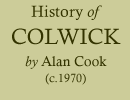< Previous | Contents | Next >
Colwick Memorial Institute
After ten years of waiting and planning, on Saturday, 13th December 1919, “The Colwick Memorial Institute” was opened for use. The day was fine and the Institute was decorated with flags, bunting and plants. The Colwick Troop (6th Nottingham) of Boy Scouts, under the command of A.S.M G. H. Hodson and Mr. Beet, formed a guard of honour outside the Institute to receive Mrs. Mason of Colwick House, (Who was to declare the Institute open) while inside the parishioners were gathered to give her a warm welcome. The proceedings began at 3—30 p.m. with Dedicatory Prayer and Thanksgiving to Almighty God. The President (the Rector), then briefly outlined the events which had led up to that day and the event, and Presented to Mrs. Mason a silver key, which bad been subscribed for by the members of the Committee as a memento of, her liberal kindness, desired her to declare the Institute open.
Mrs. Mason thanked the committee for the key and said that it gave her great pleasure in giving the £160 that the building cost and that everyone who lived or worked in the parish might come for recreation, and she had the greatest possible pleasure in declaring the Institute open. Alice Breward then presented Mrs. Mason with a bunch of orchids.
Mr. Cooper (of Messrs Lawrence & Co) proposed a hearty vote of thanks to Mrs. Mason and in doing so promised a handsome silver challenge cup for a Billiard Handicap. His vote was seconded by Mr. (Sammy) Loach (who selected the hut and superintended its erection), and carried with acclamation. Mr. Breward (Chairman of the Parish Council) proposed a hearty vote of thanks to Messrs. Lawrence & Co. who had not only allowed the Committee to have the site at a nominal rent, but had also borne all the expense of erecting and decorating the Institute. The balance left in the funds was £28, and Mrs. Mason said that she would make this up to £50. This ceremony was followed by a sumptuous tea and afterwards by dancing, which ended at 11 p.m.
The entrance fee for joining the Institute was fixed at 1s. 6d. and the monthly subscription at 6d., which was hoped to be enough to run the place on after it had been equipped. Garden Parties were run to find money for the initial set of equipment. A Whist Drive was held on the first Saturday in each month from October to April, admission 1s. 0d. All the normal indoor games including Billiards and snooker were provided for men and boys, with annual competitions for which the winners received cups.
When the newness had worn off, the membership began to fall, partly with it not being licensed, partly with it being males only and the rest must be blamed to the increase in other attractions. After the membership had fell to low too continue, the Institute was hired to William Lawrence’s as a Social Club. During the Second World War, the premises were used as a British Restaurant and a brick kitchen added on the left-hand side of the building. It opened as a British Restaurant on December 17th 1941 and closed as such at the end of 1944.
In June 1946, the Trusteeship of the Institute, which had been in the hands of the Rev. Hildesley, was handed over to the existing committee and their successors. All Church Furniture in the Institute was left there on free loan until required otherwise and the Institute committee to make good any breakages. After this handover, a license for music and dancing was taken out, which gave more scope for lettings, such as weddings, dances etc.
The principal members of the committee in 1969 were:
|
President |
Mr. S. Marshall |
|
Chairman |
Mr. Lloyd |
|
Secretary/Treasurer |
Mr. E. G. Collis. |
A campaign was at this time launched by the committee to improve the building, and at the same time Lawrences asked them to look for a new site, as they required the land.
The main idea is to develop the Institute into a Community Centre, providing a children’s play area at the rear.
In December 1972, William Lawrence and Co. gave notice that they required the land back on which the Institute stood by 31st March 1973. On the 7th February 1973, a meeting was held between the Institute committee and the directors of William Lawrence and it was decided that the Institute would close. Memorial plaques were to be removed before demolition and placed in the church. The Sunday School, Dancing class, Cricket, Cycling and Karate clubs would have to find a new meeting place. Later in that year, the building was demolished.
